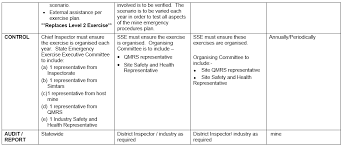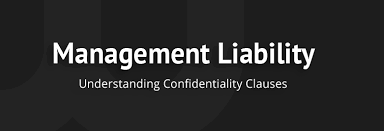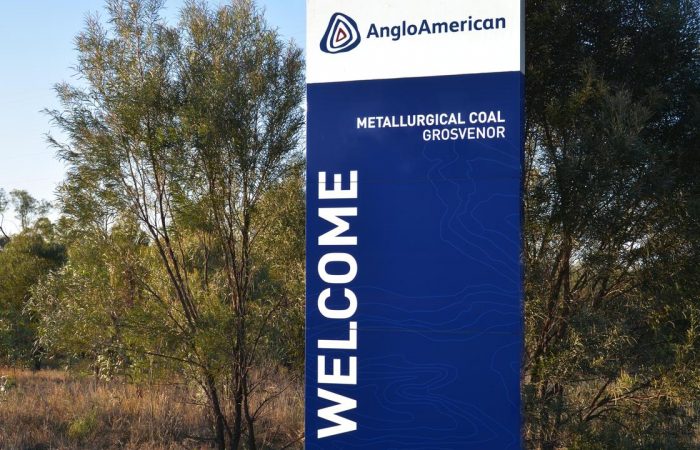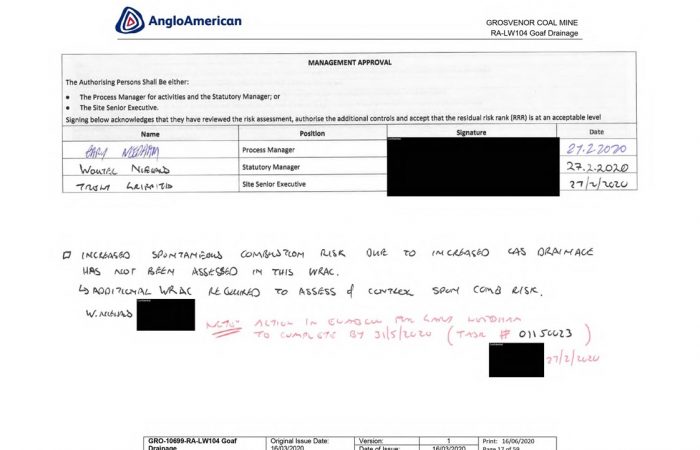
Analysis of 2021 Qld Coal Level 1 Emergency Exercise. Are we going backwards as an Industry?
There are a number of points of interest from the 2021 Level 1 Emergency Response Report from the Exercise held at Oaky North mine.
2021-oakey-north-level-1-report-2021
In order that they appear in the Report
- At least part of scenario leaked to on shift decision makers prior to the exercise. Appear to be aware that the scenario is a large long term fire underground and that Low expansion fire fighting foam would not be effective in bringing it under control.
- What should have been 8 fatalities were allowed to stop, rest, refresh, discuss the situation in what was “irrespirable atmosphere” and then to continue to participate in Exercise
- Underground Miners continue to have inadequate emergency training including in limited visibility, the donning use limitations and changeover of breathing apparatus and the concepts of self-escape and aided escape and rescue
- Mines Rescue Service not contacted till roughly 2 hours and 45 minutes after the Mine Management became aware or the vehicle incident and fire
- Mines Rescue not able to be deployed underground yet a number of Oaky North Mine Workers were still deployed underground fighting the fire and had been doing so continuously unrelieved for a number of hours
- Information provided by RSHQ to a media response reported that, “All other underground workers have been accounted for and the fire has been extinguished”. At the time a worker remained underground and was in the process of being recovered.
- External agencies, such as inspectorate, ISHRs, and QMRS, were observed not to attend the mine in a timely manner and did not remain on site until the exercise was stood down, as they would under a live emergency situation
- Many of these recommendations have been made in previous level 1 reports. Industry has not acted upon these to improve training for CMWs and establish effective emergency response systems with appropriate equipment and software. Having equipment and software available is of no use if the CMWs do not have a level of skill and knowledge to enable them to use the tools effectively. (CMWs in this sense refers to everyone at the coal mine). (page 50)
At 0100hrs there was a vehicle collision resulting in injuries to two CMWs and an ensuing fire at the incident scene, 12ct B heading.
Inbye personnel had to escape in an irrespirable, smoke-contaminated atmosphere.
- At least part of scenario leaked to on shift decision makers prior to the exercise. Appear to be aware that the scenario is a large long term fire underground and that Low expansion fire fighting foam would not be effective in bringing it under control.
UG Accident Site (page 20)
0155hrs Experienced people being swapped out from firefighting to bring up the foam generator to the fire scene
Assessor Note: No rescue personnel at scene at this point There seemed to be prior knowledge that low expansion foam would not be effective experienced CMWs being swapped out from firefighting to bring up the foam generator
Surface Under Manager page 38
Subsequently the Undermanager reviewed real time gas monitoring data throughout the mine and considered possible ventilation change tactics to support the firefighting response in the East Mains.
At 0138hrs The UM requested the mechanical shift supervisor initiate senior management to form a formal IMT. SSE/UMM David Stone, the ventilation officer (VO) and other senior managers were notified to immediately respond.
Prior to formation of the formal IMT The UM and the on-scene incident controller (ERZC) determined the use of the Turbex™ foam generator was necessary to bring the fire under control. The UM requested permission from the VO to apply the Turbex™ underground.
2.What should have been 8 fatalities were allowed to stop, rest, refresh, discuss the situation in what was “irrespirable atmosphere” and then to continue to participate in Exercise
At least in first level 1 Exercise in 1998 the scenario was run as if for real.
1998-southern-colliery-mine-emergency-exercise-report
If you run out of oxygen or had a bad changeover you got recorded as you died.
This Exercise has a full crew who are on the verge of exhaustion as well as running out of CABA carrying an injured worker on a stretcher.
Not a worry says the Assessors. Lets just stop the exercise for these blokes, Have a rest to cool down and have a chat about it.
Ok, exercise is essentially over for you blokes. Not recorded as fatalities, just put vague words into the report about more realistic training being required.
They were not also left as “fatalities” to be encountered by other escaping mine workers
One crew of 7x CMWs and 1x ERZC with an incapacitated CMW carried the CMW in a stretcher from East Mains 33ct via A heading while wearing CABA. After travelling approximately 200m in A heading it was apparent to assessors’ that risk would become unacceptable if the crew continued therefore assessors discontinued the stretcher carrying activity.
The ERZC and crew refilled their CABA (including the patients) at the CABA refill station positioned in 33ct.
At 27ct A heading it was apparent to the assessors that the physical condition of the crew members carrying the patient was deteriorating considerably and CABA air consumption rates were high. The assessors ceased the patient carrying activity to ensure an unacceptable level of risk to CMWs did not emerge
To provide an immediate learning opportunity the assessors engaged with the ERZC and crew to discuss the circumstances they were in and consider what other decisions and actions may have been appropriate for a more effective self and aided escape. The assessors then allowed the ERZC, crew and patient to continue to egress A heading and participate in the exercise.
3. UG Miners Training Recommendations
Underground Miners continue to have inadequate emergency training including in limited visibility, the donning use limitations and changeover of breathing apparatus and the concepts of self-escape and aided escape and rescue
All underground coal mines should ensure the following elements are integrated into self-escape training for CMWs. Training should include:
- training in the underground environment in simulated restricted visibility, including donning and changeover of breathing apparatus.
- varied practical self-escape scenarios underground in self-escape training, including walking via alternate escape routes.
- varied physical activities when wearing breathing apparatus during self-escape training to provide experience and knowledge for CMWs to understand their physical and equipment limitations.
- more regular desktop exercise analysis with diverse scenarios during self-escape training, including potential aided escape situations for incapacitated crew members.
- testing CMWs ability to self -escape without the assistance of the ERZC in selfescaping training.
- All underground coal mines should review the strategy of refuge for CMWs where selfescape or assisted escape from a mine is unachievable during an emergency.
Increased training if SCSR/CABA/Fire and first response – the donning of equipment was good in this group however willingness to assist in rescue/ firefighting was minimal (which is assumed due to lack of confidence/ competence) (pg27)
4. Mines Rescue Service not contacted till roughly 2 hours and 45 minutes after the Mine Management became aware or the vehicle incident and fire
The Incident Controller initiated a QMRS rescue team member response at 0355hrs (page 30)
Not all rescue team members were fully proficient and confident with some areas such as preoperational checks, newer style BG4 masks, Captains checks, two-minute stop, communication (process and expectations if off radio, travelling in a vehicle etc), application of guidelines, connection of Carevent to mask
- QMRS to consider further training to specifically highlight when teams are travelling in a vehicle inbye of FAB, including distances that can be travelled, designated return triggers, process for two-minute stop, communication challenges, etc
- All rescue team members to confirm they have adequate personal equipment such as helmets, cap lamp belts etc available to respond to an emergency either from home, camp, or site. Ensure QMRS rescue team member identification is also available.
- QMRS to review and communicate process when a fixed communication device is not operational or found to be in place at the designated FAB. Include alternatives that can be used if available. If deciding to utilise any site-specific mobile communications determine how this can be communicated so that it is prepared and ready to go with teams on deployment without causing unnecessary delays. Consider the reliability of Wi-Fi coverage.
5. Mines Rescue not able to be deployed underground yet a number of Oaky North Mine Workers were still deployed underground fighting the fire and had been doing so continuously unrelieved for a number of hours
IMT Mine (page 40)
- Consider the early initiation of a QMRS response and risk management process to provide a parallel and prepared contingent resource if the mines resources become overextended.
Ok for people underground fighting fire, then fire watch. Mines rescue you rang hours later than you should have, then argue they have not dotted every I and crossed every T with paperwork. To go find and rescue bloke still underground, RSHQ has already told media all out of mine and safe
Industry Page 42 and 45
- QMRS need to review MRAS system to streamline the process for re-entry or deployment of mines rescue personnel. For example, there were already people underground fighting a fire and yet the QMRS MRAS system delays deploying teams to assist and take over the fighting of the fire.
- QMRS should review the effectiveness of deployment procedures for Operations Managers when notified of an emergency at a mine which may require the response of mines rescue team members.
- QMRS should review the resourcing requirements required during an emergency at a mine
- to effectively apply the defined risk management process for mines rescue teams to deploy and remain underground.
- Further, QMRS should review the resourcing requirements to efficiently deliver team deployment procedures and relevant information during an emergency response at a mine e.g., Captains Task Sheets, Gas monitoring data and TARP status, Authority to enter.
- QMRS should conduct a review or audit for each underground coal mine to determine if the operational procedures developed by QMRS can be effectively applied to carry out mines rescue services at the mine.
6 MEDIA
The assessors identified the following areas for improvement:
- Information provided by RSHQ to a media response reported that, “All other underground workers have been accounted for and the fire has been extinguished”. At the time a worker remained underground and was in the process of being recovered.
- Communication between the mine’s corporate communications team and Resources Safety and Health Queensland is strongly advised to ensure accuracy of information and communication provided to the media and public.
7) External agencies, such as inspectorate, ISHRs, and QMRS, were observed not to attend the mine in a timely manner and did not remain on site as they would under a live emergency situation
This needs to be considered and communicated as part of the learnings from this exercise and recommend that the Chief Inspector of Coal Mines informs these agencies of the expectation.
Resources Safety and Health Queensland (RSHQ) Mines Inspectors
When an emergency occurs at a mine involving a High potential Incident (HPI) or serious accident prescribed by the Queensland Coal Mining safety and Health Regulations 2017, RSHQ Inspectors will attend the mine to perform their functions i.e., to provide the advice and help that may be required from time to time during emergencies at coal mines that may affect the safety or health of persons.
RSHQ and Inspectors participate in Level 1 emergency exercises to test RSHQ’s emergency response system for effectiveness and identify areas for improvement. The following is a summary of RSHQ’s participation.
- The SSE contacted the IOM (Inspector of Mines) at approximately 0200hrs informing of the emergency Exercise.
The IOM was in Emerald for other work commitments.
- At approximately 0300hrs the IOM had obtained further information regarding the emergency then escalated the information to the Rockhampton Regional Inspector of Mines (RIOM) who initiated the RSHQ emergency management system.
- Due to personal safety considerations the IOM departed Emerald in daylight and arrived at OCN at approximately 0800hrs. No other IOMs deployed to site from other locations.
- The IOM requested and obtained information and data from Members of the IMT soon after arrival.
8. Many of these recommendations have been made in previous level 1 reports. Industry has not acted upon these to improve training for CMWs and establish effective emergency response systems with appropriate equipment and software. Having equipment and software available is of no use if the CMWs do not have a level of skill and knowledge to enable them to use the tools effectively. (CMWs in this sense refers to everyone at the coal mine).
I would argue that except for the partial introduction of CABA and change over bases the standard of training for Mine Workers has not improved at all.
Otherwise why would you get a statement such as this
Increased training if SCSR/CABA/Fire and first response – the donning of equipment was good in this group however willingness to assist in rescue/ firefighting was minimal (which is assumed due to lack of confidence/ competence) (pg27)
24. 03 Self-escape (page 50)
All underground coal mines should ensure the following elements are integrated into self-escape training scheme for CMWs
- Conduct a proportion of training in the underground environment including donning and changeover of breathing apparatus in simulated restricted visibility.
- Self-escape training should involve varied practical self-escape scenarios underground including walking via alternate escape routes.
- Self-escape training should provide varied physical activities when wearing breathing apparatus to provide experience and knowledge for CMWs to understand their physical and equipment limitations.
- Self-escape training should include more regular desktop exercise analysis with diverse scenarios including potential aided escape situations for incapacitated crew members.
- Self-escaping training should include testing CMWs ability to self -escape without the assistance of the ERZC.
- All Underground coal mines should review the strategy of refuge for CMWs where self- escape or assisted escape from a mine is unachievable during an emergency.


